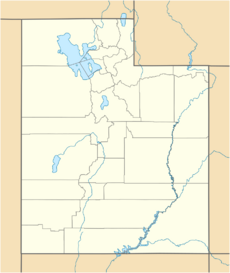Earth:Temple of the Sun (Utah)
| Temple of the Sun | |
|---|---|
 Temple of the Sun, north aspect | |
| Highest point | |
| Elevation | 5,822 ft (1,775 m) [1] |
| Prominence | 402 ft (123 m) [1] |
| Parent peak | Point 6529[1] |
| Isolation | 1.50 mi (2.41 km) [1] |
| Coordinates | [ ⚑ ] : 38°27′04″N 111°11′34″W / 38.4509836°N 111.1926556°W [2] |
| Geography | |
| Location | Capitol Reef National Park Wayne County, Utah, United States |
| Parent range | Colorado Plateau |
| Topo map | USGS Fruita NW |
| Geology | |
| Age of rock | Jurassic |
| Type of rock | Entrada Sandstone |
| Climbing | |
| Easiest route | closed to climbing[3][4] |
Temple of the Sun is a 5,822-foot (1,775-meter) elevation summit located in Capitol Reef National Park, in Wayne County of Utah, United States.[2] This remote, iconic monolith is situated 12.5 mi (20.1 km) north-northeast of the park's visitor center, and 0.37 mi (0.60 km) north of Temple of the Moon, in the Middle Desert of the park's North (Cathedral Valley) District. Cathedral Valley was so named in 1945 by Charles Kelly, first superintendent of Capitol Reef National Monument, because the valley's sandstone monoliths reminded early explorers of ornate, Gothic cathedrals, with fluted walls, alcoves, and pinnacles.[5] The free-standing Temple of the Sun towers over 400 feet (120 meters) above its surrounding terrain, which is within the Fremont River drainage basin. John C. Frémont's 1853 expedition passed through Cathedral Valley.[6]
Geology
Temple of the Sun is composed of unfractured, buff-pink Entrada Sandstone.[5] The sandstone, which was originally deposited as sandy mud on a tidal flat, is believed to have formed about 160 million years ago during the Jurassic period as a giant sand sea, the largest in Earth's history.[7] Strata in Cathedral Valley have a gentle inclination of three to five degrees to the east, and appear nearly horizontal. Long after these sedimentary rocks were deposited, the Colorado Plateau was uplifted relatively evenly, keeping the layers roughly horizontal, but Capitol Reef is an exception because of the Waterpocket Fold, a classic monocline, which formed between 50 and 70 million years ago during the Laramide Orogeny.[8]
Gallery
Climate
Spring and fall are the most favorable seasons to visit Temple of the Sun. According to the Köppen climate classification system, it is located in a Cold semi-arid climate zone, which is defined by the coldest month having an average mean temperature below 32 °F (0 °C), and at least 50% of the total annual precipitation being received during the spring and summer. This desert climate receives less than 10 inches (250 millimeters) of annual rainfall, and snowfall is generally light during the winter. Script error: No such module "weather box".
See also
References
- ↑ 1.0 1.1 1.2 1.3 "Temple of the Sun - 5,822' UT". https://listsofjohn.com/peak/23161.
- ↑ 2.0 2.1 U.S. Geological Survey Geographic Names Information System: Temple of the Sun
- ↑ Caitol Reef Rock Climbing, Utah.com
- ↑ Capitol Reef Rock Climbing and Bouldering, nps.gov
- ↑ 5.0 5.1 North (Cathedral Valley) District, National Park Service
- ↑ Peter Massey, Jeanne Wilson, Utah Trails Central Region, 2006, Adler Publishing Company, page 106.
- ↑ Capitol Reef National Park, National Park Service
- ↑ Capitol Reef Geology, NPS.gov
- ↑ "PRISM Climate Group, Oregon State University". http://prism.oregonstate.edu/explorer/.
External links
- Capitol Reef National Park National Park Service
- Weather Forecast: National Weather Service
- Temple of the Sun: YouTube
 |










